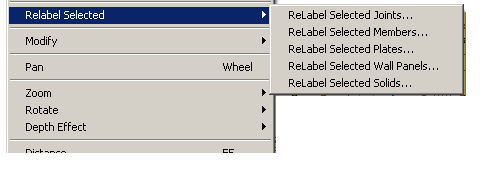 button on the Window Toolbar.
button on the Window Toolbar.You may draw, edit, and load your model directly in the model views.
You can draw members and
plates between existing
There are several graphic editing features that make the creation and
modification of models quite easy. Use the Insert and Modify
Menus or the Drawing Toolbar to utilize these features in the model
view. To create new
All model data is automatically recorded in spreadsheets and the spreadsheets and model views are always in tune (unless you turn this feature off in the Application Settings on the Tools Menu). As you edit a model graphically the spreadsheets are automatically updated and as you make changes in the spreadsheets the model views reflect these changes immediately.
All of the graphical modeling tools may be found on the Drawing Toolbar
shown below. This toolbar may be turned on and off by clicking the  button on the Window Toolbar.
button on the Window Toolbar.

The Drawing
Grid is
often useful when you are starting a new model from scratch or adding
a new section to a model. It allows
you to set up grid lines which may then be used to define the
There are also times when it is simpler
to define
Some of the graphic editing options offer more than one way to apply
a modification. This is because there are times when each option
is useful. For example, changing the material of a beam from
Use the following options to specify how you want to choose the items to modify. Choosing Apply Entries to All Selected Items allows you to use the tools on the Selection Toolbar to choose the items you want and then apply the modifications to all selected items at once. Choose Apply Entries by Clicking Items Individually to then click on the items you wish to modify individually. See Graphic Selection for more information on the selection tools.
Note
RISA-2D
provides you with unlimited 'Undo' capability so that you may easily correct
mistakes or just back up to try different possibilities. Simply
click the  button on the RISA Toolbar as many times as you wish to undo your previous actions. The model view and the spreadsheets will visually display
the "undoing". Remember that spreadsheet edits are undone as well.
button on the RISA Toolbar as many times as you wish to undo your previous actions. The model view and the spreadsheets will visually display
the "undoing". Remember that spreadsheet edits are undone as well.
Note
RISA-2D
provides you with unlimited 'Redo' capability so that you may easily redo any actions that were previously undone using the 'Undo' button. Simply
click the  button on the RISA Toolbar as many times as you wish to redo actions that were previously undone. The model view and the spreadsheets will visually display
the “redoing”. Remember that spreadsheet edits are redone as well.
button on the RISA Toolbar as many times as you wish to redo actions that were previously undone. The model view and the spreadsheets will visually display
the “redoing”. Remember that spreadsheet edits are redone as well.
Note
The generator provides the ability to generate an entire grid system at once rather than entering the grids in manually in the project grid spreadsheet.
The Drawing Grid is a tool that lets you draw new
Click the button on the Drawing Toolbar
to open the Drawing Grid Dialog shown above. The display of the Drawing Grid in the current model view may be turned on and off by clicking the button on the Drawing Toolbar. If the Drawing Toolbar is not visible in the current model view, click the  button on the Window Toolbar.
button on the Window Toolbar.
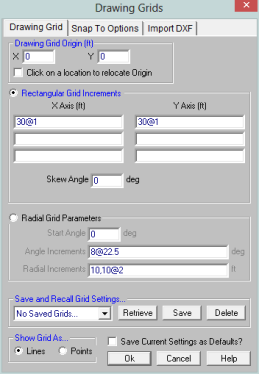
You may choose between a rectangular drawing grid or a radial drawing grid. Also, rectangular drawing grids may be skewed from perpendicular to the global axis plane.
The Save and Recall Grid Settings... section allows for drawing grids may be saved and recalled for later use. Saved drawing grids are model independent, i.e. when you save a grid, you can reuse it in any other model you are working with in the future. To save a drawing grid, click the Save button after defining the grid. You will be prompted for a name for the drawing grid and it will then be saved and added to the list of grids available for recall. To recall a previously defined drawing grid, select the grid name from the drop down list and click the Retrieve button. If you wish to delete a previously saved drawing grid, select the grid name you want to delete from the drop down list and click the Delete button.
The Show Grid As... section gives the option of displaying the drawing grid as lines from grid point to grid point or simply as a grid of points.
You may save any of the grid information as the default setting so that when you start a new model that information is already there. To do this, simply enter the information that you want to save in the Drawing Grids Dialog, check the Save Current Settings as Defaults box, and then click the OK button.
The rectangular drawing grid is defined by increments in two directions. The Drawing Grid Origin is where you want the grid increments to start. The Rectangular Grid Increments are the distances between the grid points or lines in two global directions.

You may use symbols such as "@", "/" and "," when entering the drawing grid increments.
The "@" entry may be used to specify multiple, equally spaced, grid increments. For example, if you wanted 7 increments at 10 units each, you would type "7@10" in the increment field.
The "/" entry subdivides a larger increment into smaller equal increments. For example, the entry "12/4" would create 4 increments of 3 units each.
Use commas (",") to enter multiple increments in the increment field. For example, if you wanted to define increments of 3, 4, 7 and 2 units, you could enter "3,4,7,2" in the increment field.
Once the drawing grid is specified and displayed in the model view, it will provide snap points while drawing your model.
The rectangular drawing grid can be skewed by specifying a skew angle. This option is available in the Rectangular Grid Increments section of the Drawing Grids Dialog. This skew angle will allow the creation of a regular rectangular drawing grid, but displayed in the model view at the specified angle, inclined from the global axis.
Increments in two polar directions define a radial drawing grid. The Drawing Grid Origin is the point about which the grid will rotate. The default is at the global origin (0,0). The Start Angle defines the angle from the global axis that the first spoke will be drawn. The Angle Increment controls the number and angular spacing of the spokes in the grid. The Radial Increments controls the number and location of the rings in the grid.

The origin of the drawing grid may be specified in two ways. The
first is to enter the exact global coordinates for the origin. This
can be done by entering the values in the X
Snap Points let you draw in the model view without the use of grids. To view or modify the snap point settings, click the button on the Drawing Toolbar and select the Snap To Options tab shown below.
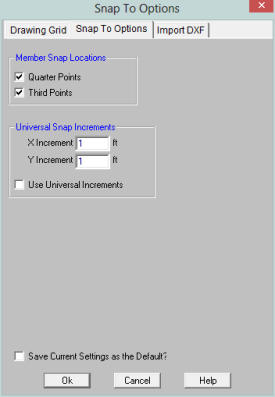
In the Member Snap Locations section, you can
set the program to automatically snap to the Quarter Points and/or Third Points
of a
The Universal Snap Increments section is used to define a snap grid for
"free" drawing to any incremental location on a plane. To activate this feature, check the Use Universal Increments box. Or, the feature may be toggled on and off in the current model view by clicking the  button on the Drawing Toolbar. If the Drawing Toolbar is not visible in the current model view, click the
button on the Drawing Toolbar. If the Drawing Toolbar is not visible in the current model view, click the  button on the Window Toolbar.
button on the Window Toolbar.
When snap points
are activated, a red dot or asterisk will appear on your screen as you move your drawing
cursor over one of these points. The exact coordinates of this point,
and whether it is a 1/3 or 1/4 point of a
Import DXF lets you import a DXF drawing into the model view as a grid. The DXF image is imported so that you can snap to any point or intersection to aid in the drawing of your model. The DXF Import Drawing Grid supports Lines, Polylines, Circles, Arcs, Polylines with Arcs, and Points.
To Import DXF Drawing Grid:
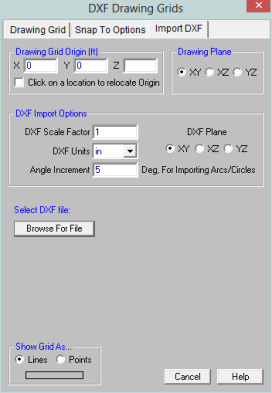
The program will default to use All Layers. Or you can select the color of the grid lines/points by clicking on the color box next to each layer name and select the color.
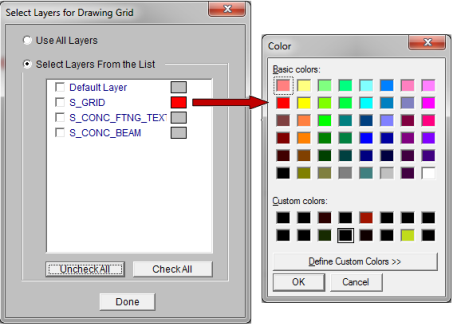
The origin of the drawing grid may be specified in two ways. The
first is to enter the exact global coordinates for the origin. This
can be done by entering the values in the X
Select the RISA drawing plane for the DXF file shall be placed.
Enter the scale factor that will cause the DXF file to be scaled up or down to full scale. For instance, if you had created a scaled model in AutoCAD at a scale of 1/4"=12", then the appropriate scale factor to produce a full size RISA-2D model would be 48. The default is 1.0.
Select the DXF drawing plane to import from the DXF file. The DXF file will be flattened to this plane and all lines/points visible from this plane will be imported.
Select the units you used in the CAD model from which you produced the DXF file. The supported DXF units are none, inches, feet, mm, cm, and meters.
The program will break an arc or circle into straight line segments to allow you to snap to them. This indicates the number of degrees the that an imported arc or circle should be broken into.
To Copy Selected Items
Note:
This allows you to copy the selected items by entering in increments in any or all of the global directions. The selected items will copy the increment distance(s) that you have entered.
Use the "@" symbol to specify multiple equal increments. For example specifying "3@10" will give you 3 copies at 10 units apart.
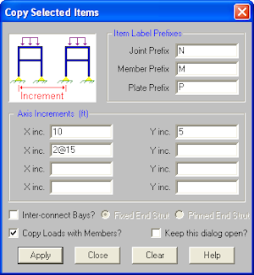
Checking the Copy Loads with Members? box will cause ALL loads associated with the original selected model elements to be copied to the corresponding newly created model elements.
Checking the Inter-connect Bays? box will cause new members to be generated that connect all member end joints of the originally selected model elements with the corresponding member end joints in the newly created model elements. You may also indicate whether the new member end releases are to be Fixed or Pinned by selecting the corresponding radial button.
Note:
You can copy the selected part of the model by rotating the copies. Simply enter the sweep angle, the number of increments along the sweep (rotation) angle, and the location of the polar origin (the point rotated about).
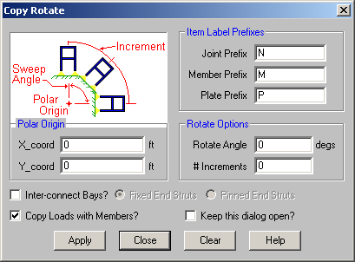
For example, suppose you wish to copy the selected part of your model in six 30° increments (for a total of 180°). You would enter "180" as the sweep (rotation) angle and "6" as the number of increments. For the polar origin, enter the X and Y coordinates of where you want the axis of rotation to pass through the XY plane.
Checking the Inter-connect Bays? box will cause new members to be generated that connect all member end joints of the originally selected model elements with the corresponding member end joints in the newly created model elements. You may also indicate whether the new member end releases are to be Fixed or Pinned by selecting the corresponding radial button.
Note
Checking the Copy Loads with Members? box will cause ALL loads associated with the original selected model elements to be copied to the corresponding newly created model elements.
You can mirror selected parts of your
model. Enter the global
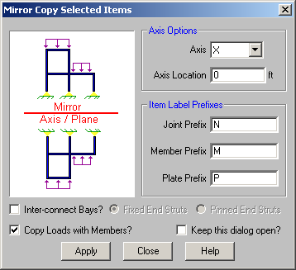
For example, suppose you want to mirror part of your model about the X axis at a location +3.0 feet from the origin. You would enter "X" as the Axis and enter a "3.0" for the axis location.
Checking the Inter-connect Bays? box will cause new members to be generated that connect all member end joints of the originally selected model elements with the corresponding member end joints in the newly created model elements. You may also indicate whether the new member end releases are to be Fixed or Pinned by selecting the corresponding radial button.
Note
Checking the Copy Loads with Members? box will cause ALL loads associated with the original selected model elements to be copied to the corresponding newly created model elements.
To Move
To move the selection
in a polar fashion click the Rotate![]() button
and specify the axis and angle.
button
and specify the axis and angle.
Note:
You can move the selected part of the model. Just enter the desired translation distances in the global axes directions.

To rotate the selected parts of the model enter the desired rotation angle and the coordinates of the polar origin (the point rotated about). Instead of specifying coordinates for a polar origin, it may instead be chosen by clicking in the model view. Select Click Joint in Model View, specify the appropriate Rotation Axis and Rotation Angle, then click Apply. The cursor will show a crosshair, with which a polar origin may be specified by left-clicking on a Joint or snap point.

For example, say you wish to rotate the selected part of your model 90°. You would enter "90" as the rotate angle. For the polar origin, enter the coordinates of where you want the axis of rotation to pass through the XY plane.
The scale feature allows you to change the size of selected items. Selected joints, members and plates are all affected when the scaling is applied. Loads are not scaled except distributed and surface loads that are a function of the size of the element.

Enter an origin about which to scale and a scale factor to apply to each global direction. The origin is the point that remains stationary during the scaling. The factors are applied in each direction to adjust the joint coordinates, member lengths and plate sizing. The factors work so that a factor of one has no affect, a factor of two will double the size of the item, and so on.
What is actually happening when you scale items is that the joint coordinates that define these items are being moved. For this reason the scaling is applied to all selected items plus unselected joints of selected items. For example if you have selected members to scale but have unselected some of the end joints, the joints are scaled anyway since this is the only way to scale the member.
Note
To Scale Selected Items
Note
As you build your model, you may find that you will need to perform a model merge from time to time. In fact, if you count on doing this, you can generally build your models faster and let the model merge feature do a lot of the work for you. See Merge Tolerance to learn about inputting the merge tolerance.
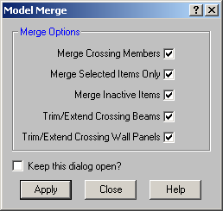
To Perform a Model Merge
As you modify the model, you may find that you will need to trim or extend a member. The Trim/Extend tool will allow you to modify the ends of any member in relation to another member. This extension is for members only, not walls or plates.
Note
To Perform a Trim
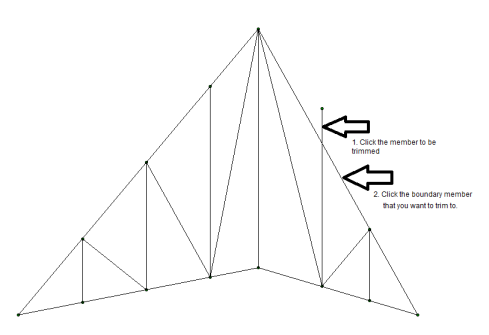
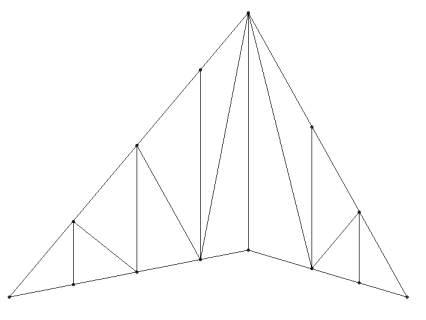
To Perform an Extend
Click
the Extend![]() button twice or select Extension by clicking the arrow.
button twice or select Extension by clicking the arrow.
Example 1:
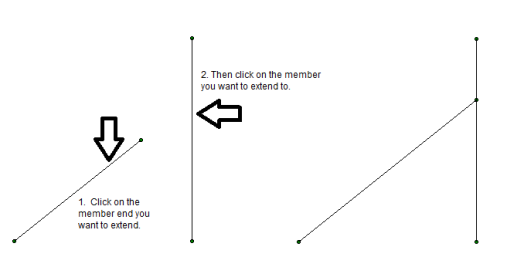
Example 2: The Extend tool can also be used to extend a member to intersection of that member's projected location.
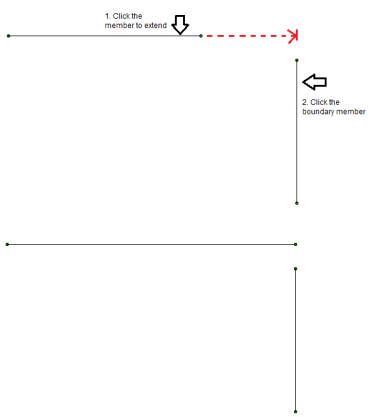
You can delete parts of the model based on the current selection state, or you can click on the items you wish to delete individually. If you accidentally delete something you didn't want deleted, you can use the Undo feature to repair the damage.
If you wish to delete based on the current selection state, you must
use the check boxes to define the criteria the program will use to perform
the deletion. Only items that are selected and that have their check
boxes "checked"
will be deleted. The choices let you delete
Keep in mind that if
you delete
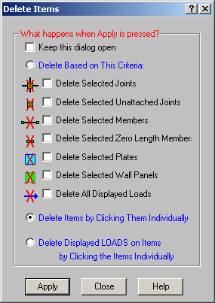
If you request deletion of displayed loads, you'll get exactly that.
Any load currently displayed will be deleted. By controlling what
loads are displayed via the Loads tab in the Model Display Options Dialog,
you can easily delete specific types of loads for particular
Alternatively, you can choose to delete items by clicking on them individually.
A final choice is to delete loads individually by clicking on the item the load is applied to. Select Delete Displayed LOADS on Items and then click the items (joints, members or plates) whose displayed loads are to be deleted. For example, if you wish to delete certain distributed loads, first use the Loads tab in the Model Display Options to display the loads to be deleted, then choose the Delete Displayed LOADS on Items option and proceed to click on the items to which the loads to be deleted are applied.
Remember to click the Apply button to make your choices active.
To Delete Selected Items
Note
You can use the right-click menu in the program to re-label only the selected items. This is useful when you want all members at a certain elevation to have a prefix which denotes the floor on which it is located.
